Given the hype, several core developers from Bitcoin.com applied for these events. We had an amazing time diving into this new trend, not just as observers but as participants too.
Together we’ve joined multiple hackathons, tested our ideas against the best, and even earned finalist spots with prizes along the way. In this article, I would like to share our journey and the key insights gathered from the experience during the last few major events.
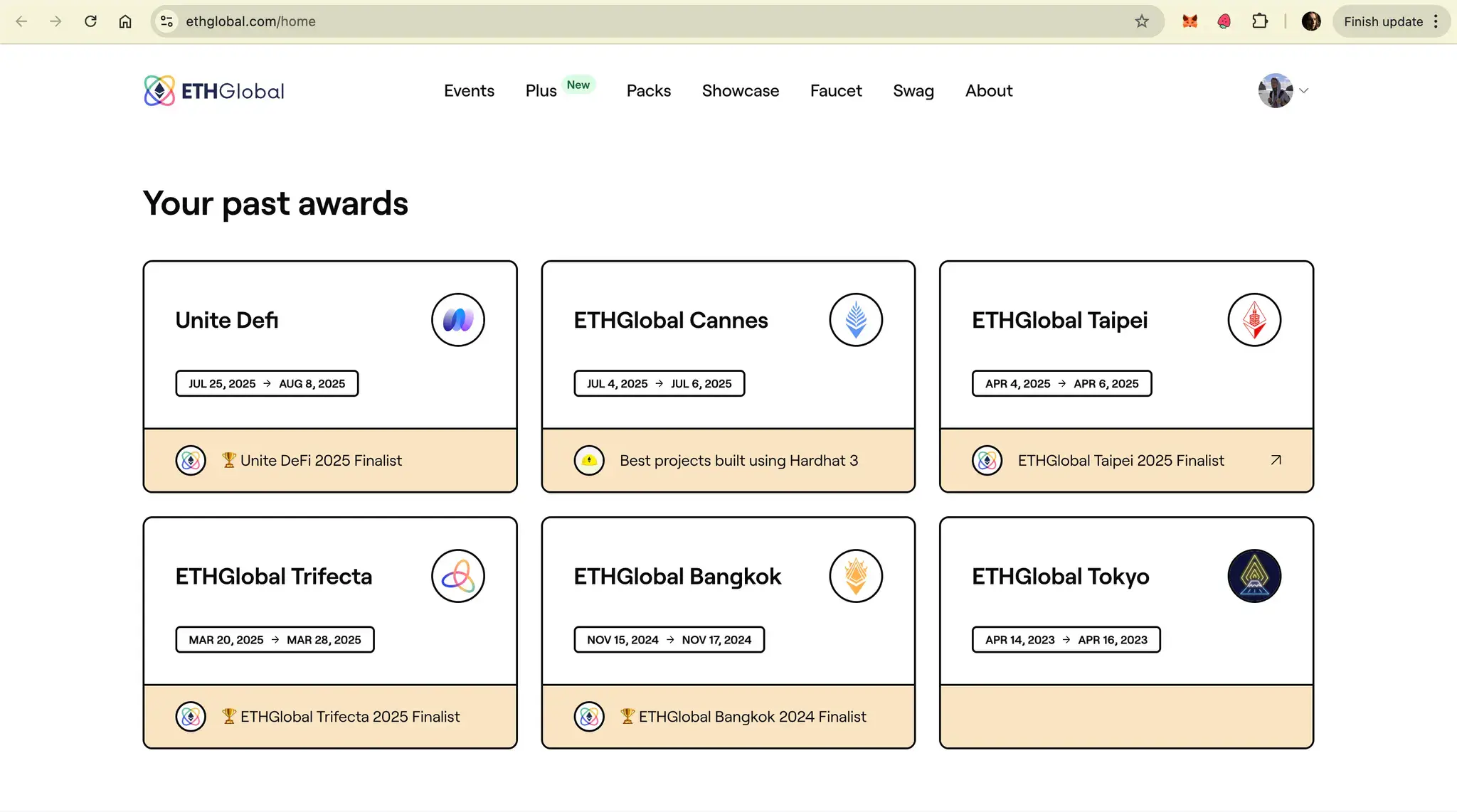
Participation and Achievements During 2023-2025 Events
Rising Prize Pools and Sponsorship
One clear trend in crypto hackathons is skyrocketing prize pools, reflecting both industry growth and fierce competition to attract top talent. In the early Ethereum hackathon days, prizes were often in the tens of thousands of dollars. Now, global hackathons routinely gather six-figure prize pools funded by sponsor bounties and protocol grants.
The ETHGlobal Bangkok 2024 hackathon last year featured a record $800,000 in total prizes. This huge bounty drew an equally record-breaking response: 713 project submissions from nearly 2,000 developers, all bringing their top game for a slice of the pie. But you might win just a fraction of these pools, as each hackathon usually tries to distribute funds between as many compelling projects as possible, focusing on different tracks, tech, and categories.
In a well-organized hackathon, you will have to choose which track and sponsor you would like to apply for, picking up to three bounties, and the pool of each sponsor is also segmented between several topics. It is good to start looking into the sponsor tech early. Most of them announce beforehand, but more is added and revealed closer to the start of the event.
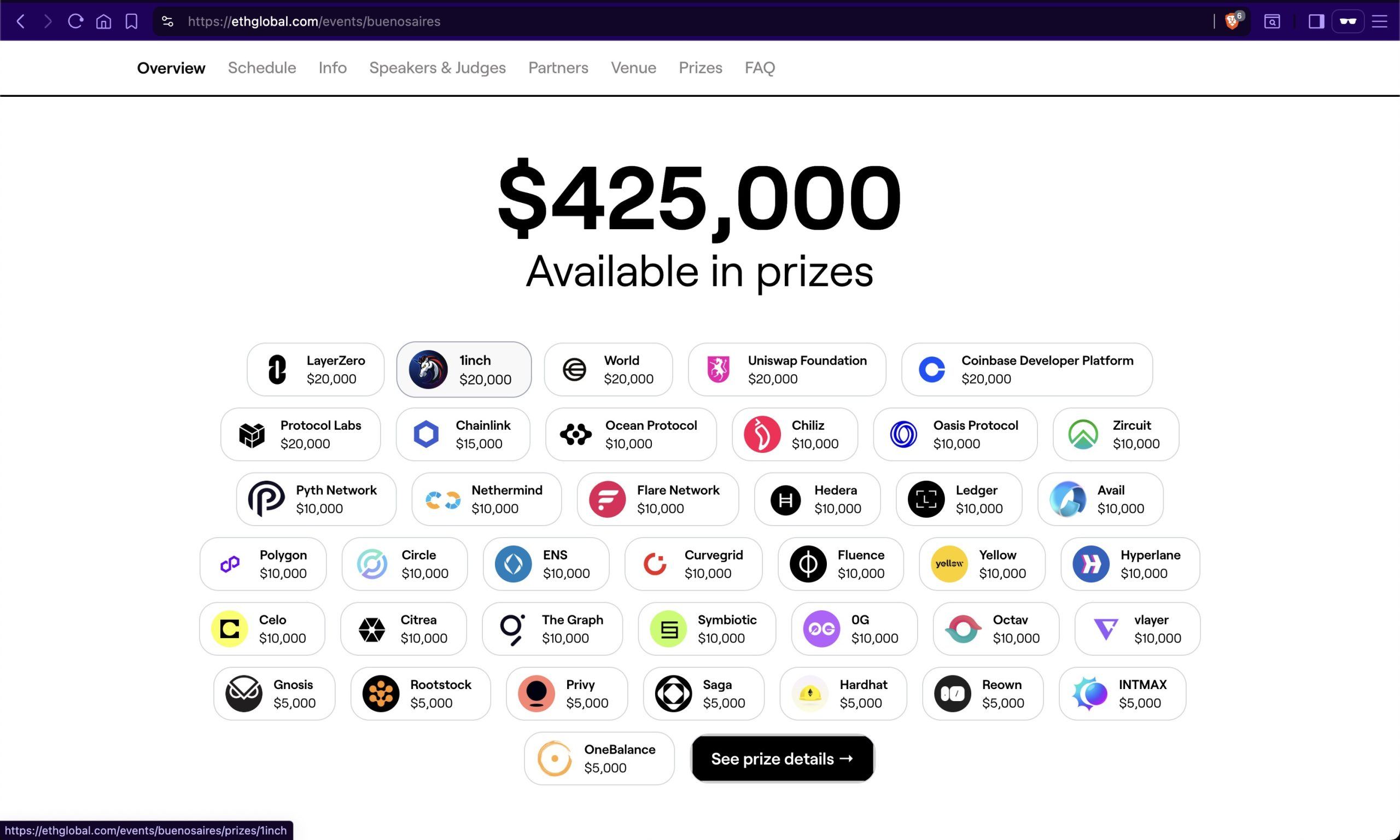
Upcoming sponsors for ETHGlobal Buenos Aires 2025 (https://ethglobal.com/events/buenosaires/prizes)
Did you know that this bounty boom isn’t limited to physical events only? Online hackathons have also seen prize pools surge. The Unite DeFi 2025 virtual hackathon mentioned earlier had $550,000 in prizes, making it one of the largest online Web3 hackathons in recent years.
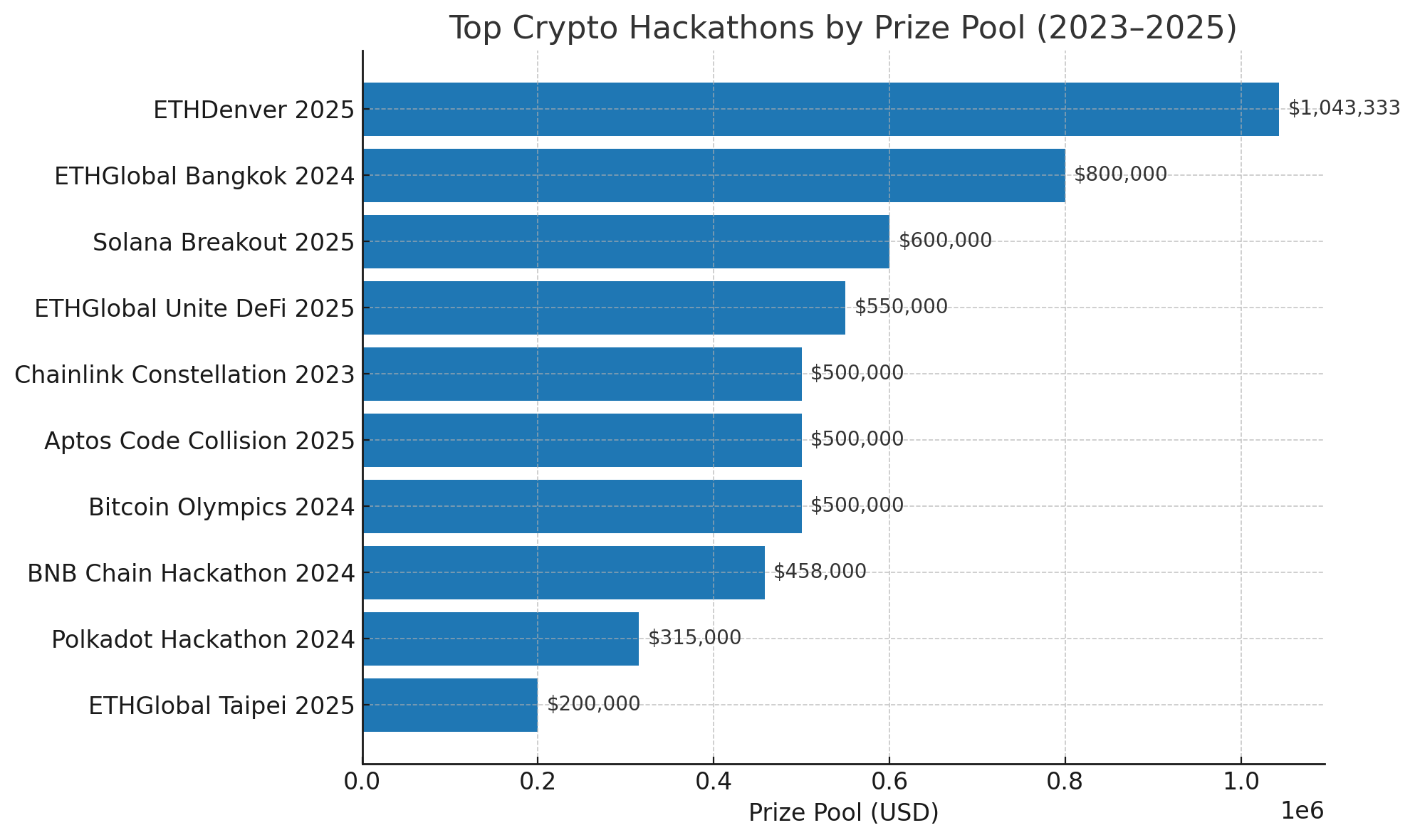
Top Blockchain Hackathons By PrIze Pool 2023-2025 (Concluded)
But wait until you see what is still yet to be distributed when it comes to ongoing hackathons.
For example, the HeDERA Africa Hackathon 2025 (Aug. 1–Sept. 30, 2025) offers $1,000,000 in prizes, so if you would like to try your skills, this could be an amazing opportunity for you and your team. This hackathon is ongoing, yet you can often join these in the middle, while others require pre-registration and are closed for hackers coming after the opening ceremony.
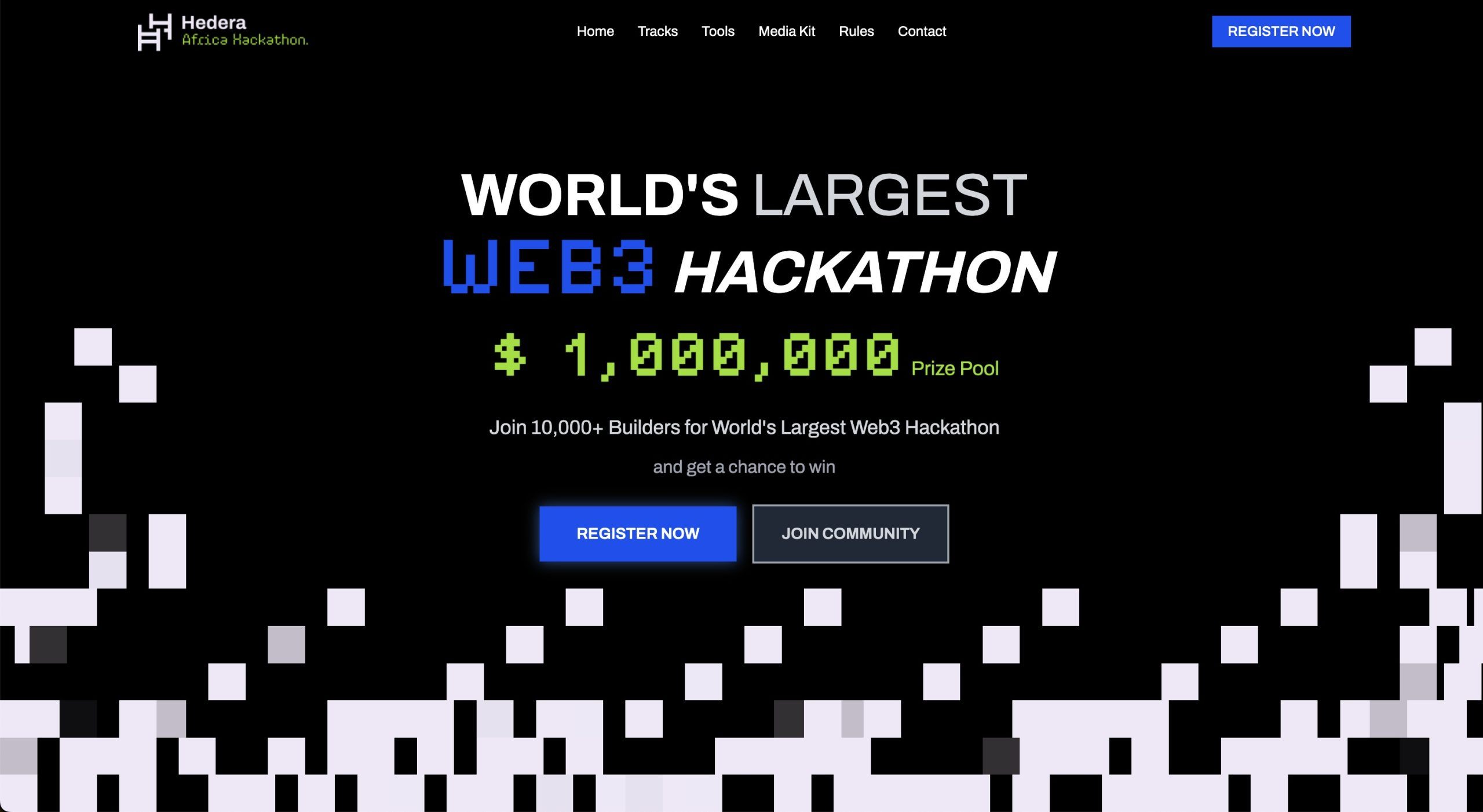
https://hedera-hackathon.hashgraph.swiss/
For sponsors, these events are a way to promote their ecosystems: a layer-2 project or defi protocol may offer big bounties to encourage developers to integrate their APIs or build on their platform. This gives great incentives to try some technology that you’ve always wanted to experiment with, but did not have enough motivation to pick up after working hours.
For participants, the stakes (and potential payoff) are higher than ever, which intensifies the competition. However, seasoned organizers emphasize that hackathons are about more than just prizes – many hackers join to learn new skills, network with peers, and maybe land a new job or funding for their project.
As prize pools climb, hackathon judging has become an essential task, and top events enlist dozens of judges to evaluate projects on innovation and technical execution.
What we’re also seeing is the professionalization of hackathons, acting like a booster for talent and idea discovery. Once centered on token prizes and bragging rights, today’s events provide structured pathways from prototype to production, often with immediate access to venture funding and accelerator programs.
But with this professionalization come new challenges. Veteran teams increasingly dominate, sometimes preparing weeks in advance despite “fresh start” rules. Organizers have responded with measures such as first-time hacker tracks and stricter code verification systems, yet the tension between accessibility and competitiveness remains.
There’s also a rule that a repository must not contain a single commit with thousands of lines, but rather have a commit history with a gradual buildup of the project. Here’s my repository for the latest online hackathon that I’ve participated in: https://github.com/vm06007/teleport. It was submitted early this month during the 1inch Unite DeFi 2025 event, securing a finalist spot.
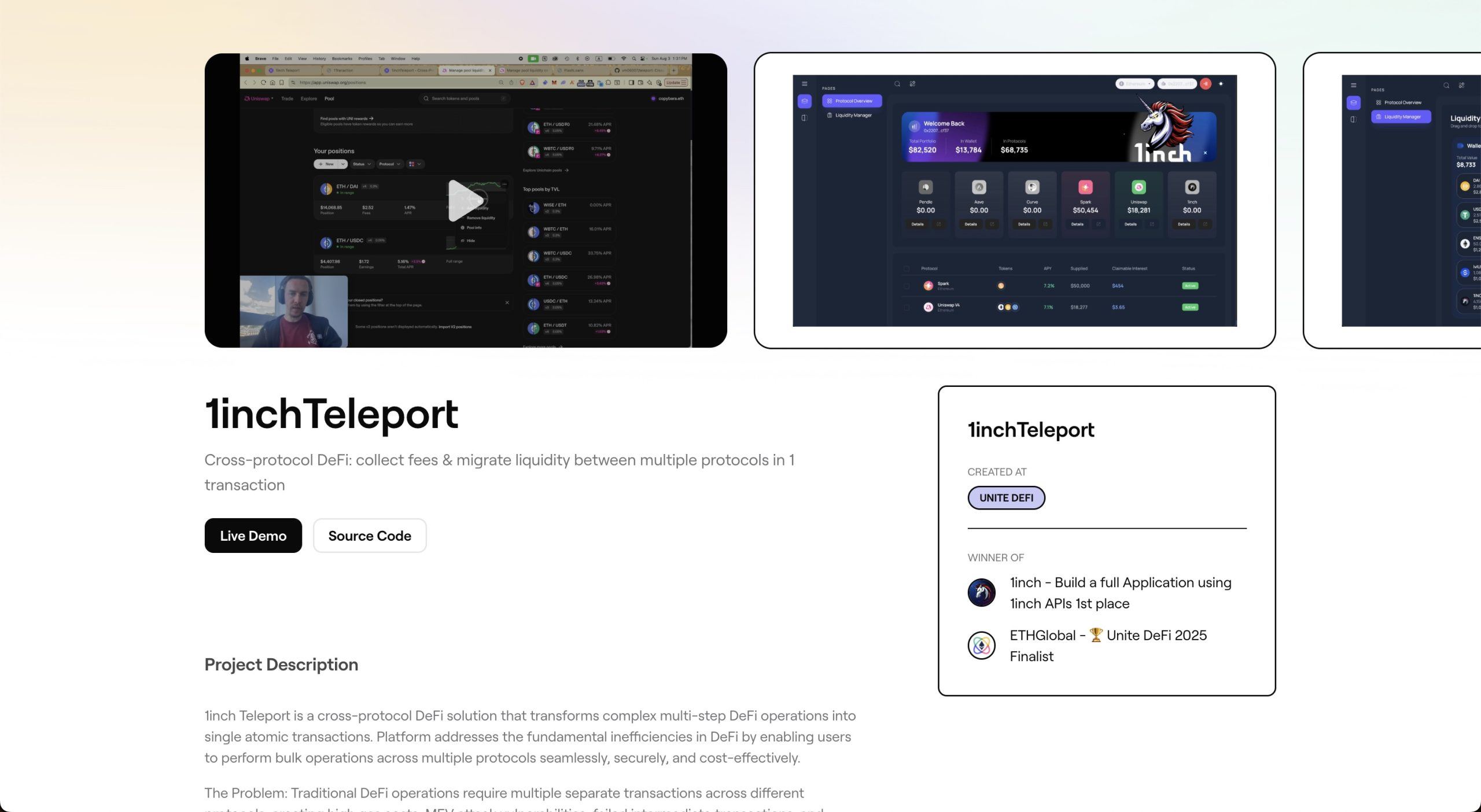
https://ethglobal.com/showcase/1inchteleport-huiuk
Some organizers have even gone further by introducing an invite-only hackathon reserved exclusively for past finalists, for example, ETHGlobal Trifecta. This competition is widely regarded as the Champions League of hackathons: a high-stakes arena where only the most accomplished builders return to test their skills against each other.
By design, it raises the bar for what a hackathon can be, transforming the format from an entry-level gateway into a proving ground for elite talent. Participating in such an event was quite challenging, but securing a top-five spot as a result was worth the time with a team. This specific hackathon did not allow solo participation and required attendance as a team.
For some, it is critical to find a well-established team or form one to work together productively, similar to sports teams. However, data show that finalists often come as solo hackers too.
For me personally, the Unite DeFi 2025 hackathon was the first solo event where I did not manage to team up with others. It is a big difference to code everything from scratch on your own as opposed to hacking within a strong team. So it is also quite important to know your community and people in these events, or connect and form alliances with other finalists.
One of blockchain hackathons’ most underappreciated aspects is their role in community building. With the mission of bringing developers on-chain to build the future of the internet, these events serve as crucial onboarding mechanisms to Web3, too.
Every hackathon feels like a reunion. Veterans from past events reunite, picking up threads of new project ideas or just catching up. Around 70% of attendees are returning builders, many of them “professional hackers” like athletes, who travel from city to city chasing the next challenge. But hackathons are not closed circles. Roughly 30% of participants at each event are brand-new to Web3, brought in through the low-barrier, high-energy format.
This duality of familiar faces and newcomers ensures that hackathons are simultaneously community glue for onboarding and reasons to come back. From my personal experience and observation, you start recognizing the same familiar faces after just a few events, or by scrolling through photos of previous hackathons and seeing people from the most recent event you’ve attended.
One of the notable hackers I’ve had the pleasure to speak with was Jordan Stojanovski, who exemplifies this new wave of hackathon professionals. The 60-year-old retired fintech expert, who sold the domain jordan.com to Nike after 15 years of patience, now dedicates his retirement to Web3 hackathons. He keeps a clean record of all his achievements, focusing on defi improvements and zero-knowledge cryptography applications.

I’ve had the honor of connecting with Jordan during several recent hackathons, where we discussed the challenges of hacking solo versus building as part of a team. If you’d like to explore his impressive track record, you can check out his portfolio or read this notable article about his journey from fintech to Web3.
One of the most powerful aspects of hackathons is the mix of veterans and newcomers. Experienced builders often take first-timers under their supervision, guiding them through the entire process. What started as informal peer-to-peer support has become so valuable that many organizers now bring in dedicated mentors as a standard feature at major events. These mentors are always on hand to help with technical issues, idea development, or coding roadblocks – ensuring participants can focus on learning and building.
Equally important are the connections forged in this environment. The shared “let’s win this” mindset often transforms casual teammates into lasting collaborators. Many hackers will tell you the people you meet at a hackathon frequently become your next teammates, close friends, or even co-founders of the next unicorn startup.

The most compelling validation of the hackathon model comes from its unicorn graduates.
1inch Network, now processing nearly $500 billion in total swap volume, was born at ETHGlobal New York City in May 2019. Founders Sergej Kunz and Anton Bukov built the first dex aggregation protocol over “56 sleepless hours” after participating in 17 hackathons together. By December 2020, just 18 months later, 1inch achieved well-deserved unicorn status.
CryptoKitties, created at the inaugural ETHWaterloo hackathon in October 2017, spawned Dapper Labs, which reached a $7.6 billion valuation by September 2021. The four-person team introduced the ERC-721 NFT standard during the 36-hour event. Dapper Labs went on to create NBA Top Shot, attracting more than 1.1 million users and facilitating $780 million-plus in trades, while partnering with major sports leagues.
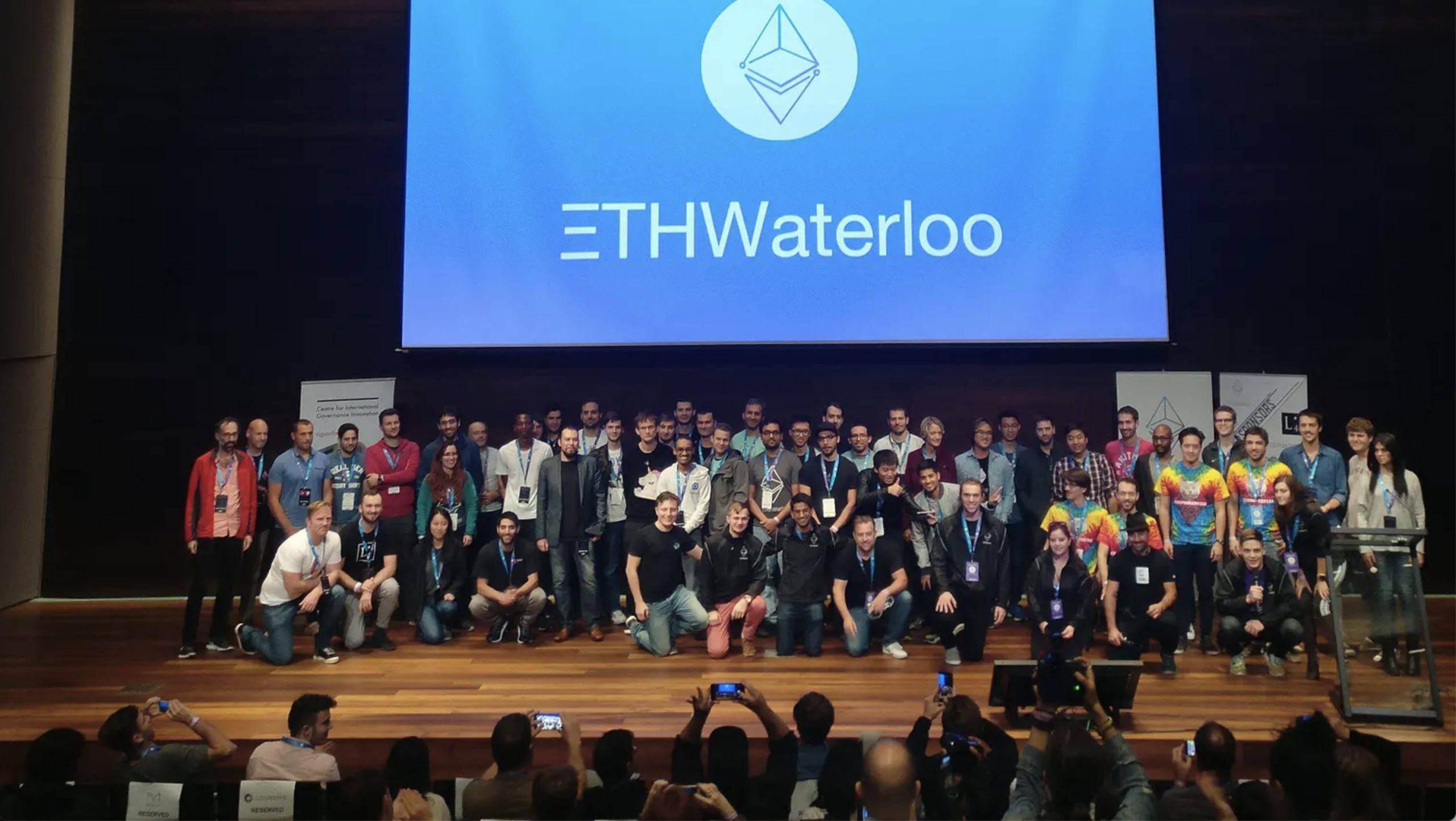
ETHWaterloo 2017 event participants.
These success stories reveal a pattern: hackathon-to-unicorn timelines typically span 18-42 months, with teams leveraging initial prototypes and community connections to build substantial businesses. The combined peak valuations of verified hackathon-originated unicorns exceed $10 billion.
Start by honestly evaluating your strengths. Are you stronger at smart contracts or front-end development? Join the hackathon’s Discord server early; most teams form before the event begins. Look for complementary skills: if you’re a developer, find a designer and someone with business skills.
You can also look at previous events and pay attention to the finalists and their presentations on stage. Often, this helps to understand what judges are looking for and what kind of demo format you should be practicing.
Study the sponsor technologies and available bounties. If Chainlink is sponsoring, understand their oracles. If Polygon is involved, practice deploying on their network. Set up your development environment completely – you don’t want to waste precious hours during the event on configuration. Clone boilerplate repositories and have starter code ready. Like in music, the best improvisation is the one you learn by heart.
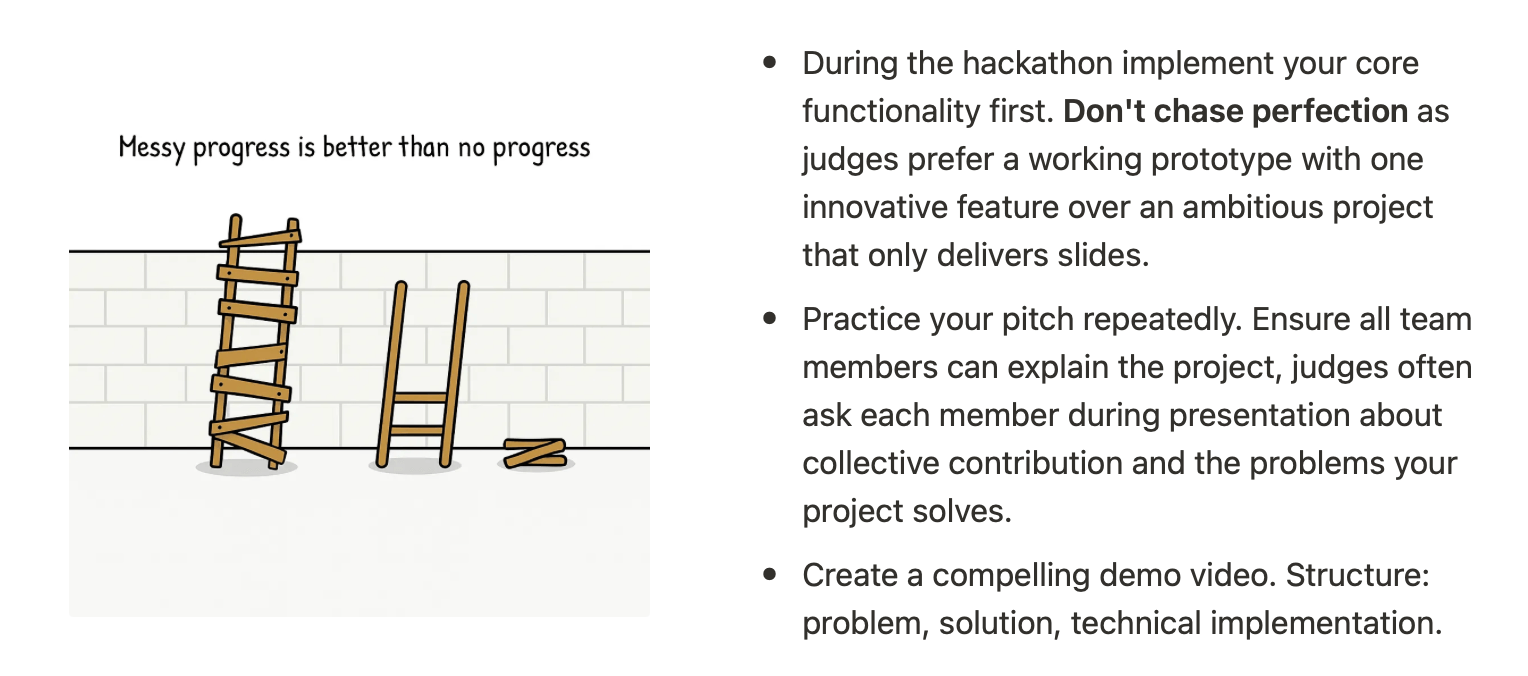

https://ethglobal.com/events/buenosaires/info/details#judging-criteria
Understanding sponsor motivations can dramatically improve your chances of winning bounties. Based on interviews with sponsor representatives and analysis of winning projects, companies participate in hackathons for several important reasons:
- Product adoption – sponsors want you to use their SDKs, APIs, or protocols.
- Real-world use cases – they look for creative applications of their tech.
- Developer feedback – hackathons serve as usability testing for their tools.
- Talent discovery – sponsors scout promising builders and teams.
- Ecosystem growth – projects that expand integrations and network effects.
- Marketing and visibility – demos provide content and brand exposure.
- Partnership opportunities – potential pilots or collaborations post-hackathon.
From my own experience, the best strategy is to approach potential sponsors as early as possible during the event. Don’t wait until the end; start conversations right away. Pitch your idea, get their perspective, and if possible, return later with a simple demo or prototype. Even a brief consultation on how their technology could integrate into your project can give you an edge.
This early feedback is invaluable for shaping your direction and increasing your odds of winning a bounty. At the same time, keep an eye on your competition and identify tracks where fewer teams are applying; sometimes the less crowded categories offer the best chances and let you win not only bounties but also assemble a project that stands out from the crowd, securing a finalist spot.
If you do everything right, expect to take the stage and present your idea in front of the crowd.
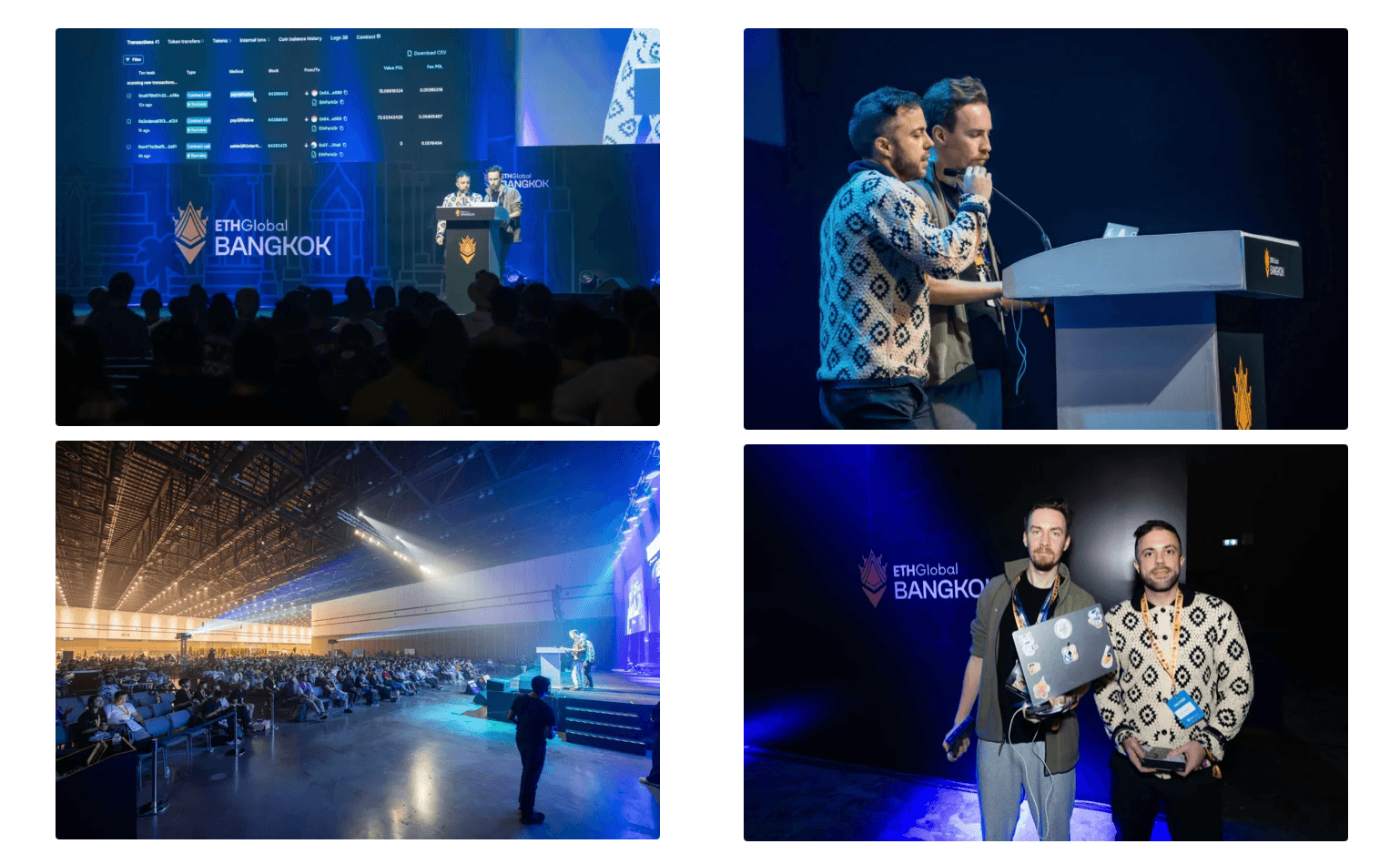
But winning the hackathon is only the beginning. According to ETHGlobal’s data, only about 15% of winning projects continue development. To be in that 15%, you need to take deliberate steps right after the event:
- Maintain momentum: Set up team meetings within 48 hours to keep the energy alive.
- Engage with sponsors: Many offer follow-up programs, grants, or accelerator opportunities – don’t let those slip by.
- Build in public: Share updates on social media, stay active in Discord, and let the community see your progress.
- Keep exploring: Reuse and refine your idea at other hackathons; many events allow existing projects as long as you keep building on them.
By acting quickly, staying visible, and leveraging sponsor relationships, you’ll give your project a real shot at living beyond the hackathon weekend.
As the year moves into its final stretch, the global hackathon circuit shows no signs of slowing down. From Africa to South America, and from in-person gatherings to large-scale online competitions, 2025 is shaping up to be one of the most dynamic years yet for builders. The upcoming calendar is packed with high-stakes events offering million-dollar prize pools.
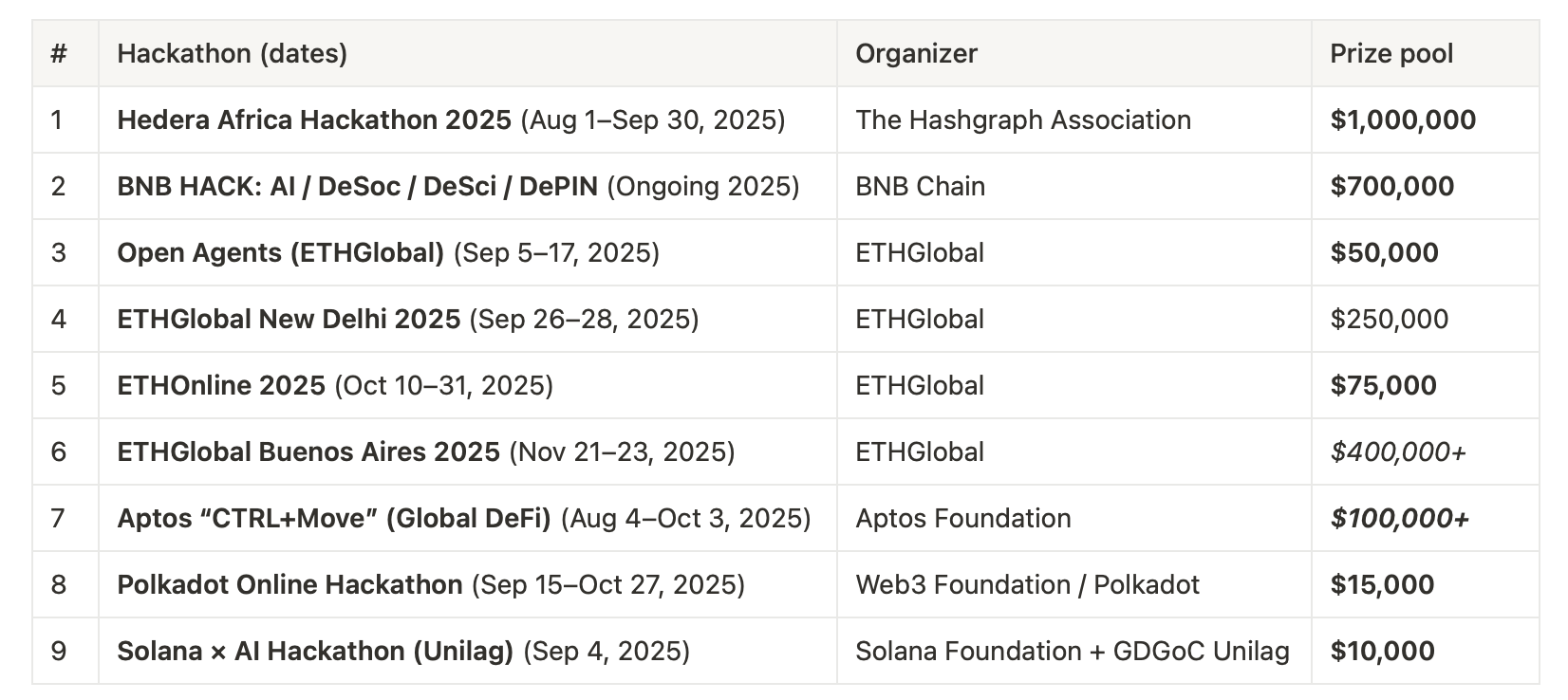
Blockchain hackathons have matured from grassroots meetups into essential infrastructure for Web3. They now serve multiple purposes at once: talent pipelines for protocols, launchpads for entrepreneurs, networking hubs for the community, and, perhaps most importantly, onboarding gateways where a large share of participants discover Web3 for the very first time.
The impact is measurable. ETHGlobal alone distributes more than $2.7 million in annual prizes, with prize pools growing nearly 60% year-over-year. Several projects that began as hackathon experiments have gone on to achieve unicorn valuations exceeding $10 billion. In many ways, hackathons function as accelerators compressed into a single weekend.
For developers, the opportunity is unmatched: compete for six-figure prize pools, receive hands-on mentorship from industry leaders, meet future co-founders, and potentially turn a prototype into the next billion-dollar protocol – all within 36 hours. Whether you’re entering Web3 for the first time (as 30% of participants do) or a veteran like Jordan Stojanovski, who now treats hackathons as a post-career hobby, these events create spaces where everyone can contribute and grow together.
For the broader industry, hackathons drive renewal. Each event injects fresh talent and ideas while giving experienced builders a chance to mentor the next wave. That cycle of continuity and innovation is what keeps the ecosystem vibrant, forward-looking, and impossible to ignore.
免责声明:本文章仅代表作者个人观点,不代表本平台的立场和观点。本文章仅供信息分享,不构成对任何人的任何投资建议。用户与作者之间的任何争议,与本平台无关。如网页中刊载的文章或图片涉及侵权,请提供相关的权利证明和身份证明发送邮件到support@aicoin.com,本平台相关工作人员将会进行核查。




